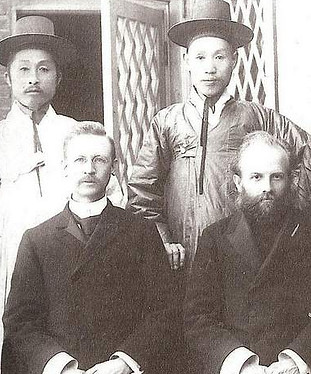OUR HISTORY


July 2
July 2 was the date when the Second Continental Congress voted to declare independence from England. July 4 was when we formally adopted the specific written text of the Declaration of Independence), but we declared independence on July 2. Coincidentally, on July 2, 1872, 96 years to the day after the Second Continental Congress declared independence, 50 individuals from First Presbyterian Church took a bold step. They had prayerfully thought about what it meant to be future focused, held a prayer and worship service, and—on that date—they were inspired to be part of a new mission church, separating themselves from the past and stepping into a new opportunity.
That church came to be known as the Second Presbyterian Church of Norfolk. It was called “Second” Presbyterian, because it was started by individuals at First Presbyterian who saw the need to minister to the growing west end of Norfolk.
By 1873
this new mission church had a pastor, but no building yet, so Second Presbyterian Church still shared a facility with First Presbyterian, with First worshiping in the morning and Second in the evening. Land was bought at Freemason and Boush Street and, by the latter part of 1873, construction was completed, and Second Presbyterian moved into the facility we now know as the Freemason Abbey Restaurant. Our first worship service there was on Oct. 19, 1873. Second quickly came to be known as “the friendly church.”

During this same time, we supported William Reynolds, a young man who grew up at Second, to be a missionary. The mission field in Greece had shut down, and so there was a need for a missionary to go to a new mission area that—at the time—was very far away. Reynolds was a linguist, and he had a tremendous impact in the mission field, so much so that Second sent a number of missionaries to Korea. Reynolds taught at a seminary in Korea for over 30 years, established several churches, and was seen as the key theologian in the development of the Korean missions. Maybe more significantly, he was known as “the father of Korean Christianity,” in part because he was the first person to translate the Bible into Korean. The small “friendly” church gained a reputation for being not just joy filled but also mission minded.
Until 1902
For 29 years, until 1902, we continued to worship at Freemason Abbey but then sold the building to Christian Scientists and moved to a different mission location on Yarmouth Street. Until that building was finished, we needed a place to worship. Ohef Sholom, a Reformed synagogue, offered us space, so through the generosity of this Jewish congregation, in 1902 we worshiped there on Sundays and Wednesdays.
December 1960
Eventually we moved into the Yarmouth location, which served us well for 59 years. But as flooding in that location continued, and as we saw opportunities to minister in a new area, a tract of land was found on Hampton Boulevard. We sold the classic Gothic-style building on Yarmouth to the Calvary Assemblies of God church, which later sold it to the Unitarians, who sold it to the Hague School. As we began to build on Hampton Boulevard, we recognized that the land was marshy and soft, so there was a need for a great amount of backfill. William Cathey, a session elder and the owner of the local Coca-Cola bottling plant, brought a tremendous number of crushed green Coke bottles to be used as backfill. The first worship service in this location was in December 1960.



The scripture that was the focus of that worship service was John 12:32, where Jesus says,
“And I, when I am lifted up from the earth, will draw all people to myself.”
That was intentional, since John 12:32 was s the passage that was used in our worship service in our first permanent location, in 1873, at our location on Freemason Street. That passage was then represented in a stained-glass window in our second location, on Yarmouth Street. But when we moved to Hampton Boulevard, that window came with us and is featured centrally.

When Koreans visit our congregation to see where “it all began,” they frequently are struck by the smallness of our church building, but they also are moved by the stained-glass window. It is a reminder of the need for the centrality of Christ in our world.


The term “Second” has been a rare name for a church. A decade ago, there were something like 2842 congregations in the United States named First Presbyterian, but only 64 named Second Presbyterian. We know that we are small, but we also know that we are both small and mighty.


Second Presbyterian Church—from its inception—has been joy filled, future focused and mission minded. Historically we have looked beyond ourselves to see where people’s needs aren’t being met. And we have sought to meet them with joy.

